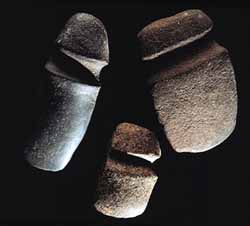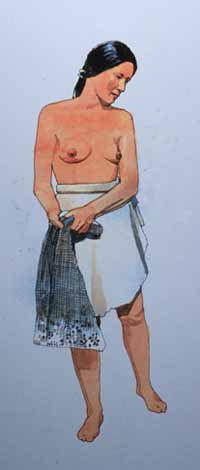
 |
Grooved axes, central Illinois. | |
|
Paleo-Indian people relied on chipped stone tools. Archaic people developed a new way of making tools by slowly pecking and grinding a rock into the shape they desired. A common Archaic ground stone tool is the grooved axe. The tapered bit was used to chop or split wood. The blunt end of the axe was used as a hammer. The axe was secured in a spilt wooden handle. The top of the handle above the axe was bound together with sinew made from the tendon of an animal. As the sinew dried, it pulled together the ends of the split handle like a vise and limited the movement of the axe. |
||
Archaic technology included ground-stone tools for cutting trees and processing plant foods, and objects of carved bone and shell for implements and ornaments.
To make a grooved axe, Archaic Indians shaped igneous and metamorphic rocks by slowly pecking away bits of the surface and then smoothing it with an abrasive material like sandstone. A wooden handle was lashed to the groove for better leverage to cut and shape wood.
Using grinding stones, Archaic women ground seeds and nuts into coarse meal to add to porridge-like soups and stews. Nutting stones held nuts in position to be cracked open with a single blow from another stone.
 |
Artist's illustration of a woman with net bag collecting food. | |
|
Based on studies of people worldwide who hunt and gather for food, women are generally responsible for gathering. Depending on their needs and the season of the year, work parties of women, and perhaps children, would travel to a location known to have a desired resource. This woman is collecting mussels from a stream. |
||
|
|
Copyright © 2000 Illinois State Museum